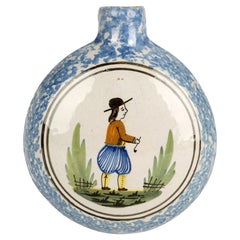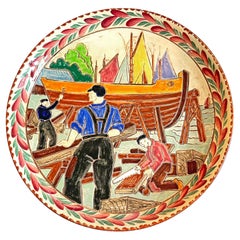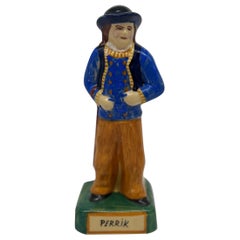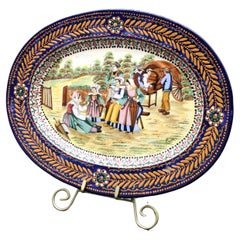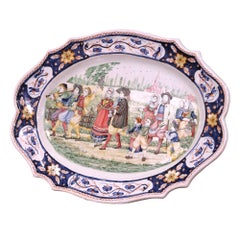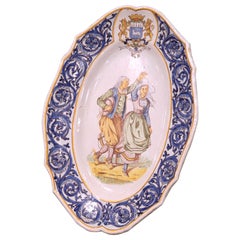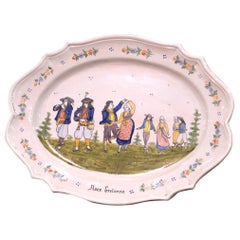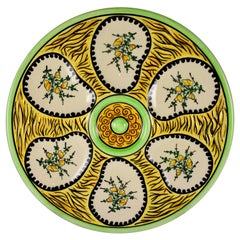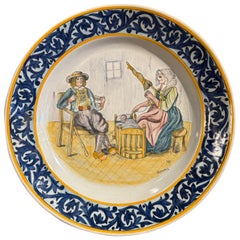Antique Quimper Pottery
Late 19th Century French French Provincial Antique Quimper Pottery
Pottery
1920s French Art Deco Antique Quimper Pottery
Ceramic
Early 20th Century French Antique Quimper Pottery
Ceramic, Faience
Early 20th Century French Antique Quimper Pottery
Pottery
Early 20th Century French Antique Quimper Pottery
Faience
Early 20th Century French Antique Quimper Pottery
Faience
Early 20th Century French Antique Quimper Pottery
Faience
Early 20th Century French French Provincial Antique Quimper Pottery
Earthenware
Early 20th Century French Antique Quimper Pottery
Faience, Ceramic
Early 20th Century French Antique Quimper Pottery
Faience
Late 19th Century French Antique Quimper Pottery
Ceramic, Faience
Late 19th Century French Antique Quimper Pottery
Faience
Early 20th Century French Antique Quimper Pottery
Ceramic, Faience, Wood
Late 19th Century French Antique Quimper Pottery
Ceramic, Faience
Early 20th Century French Antique Quimper Pottery
Faience, Ceramic
Early 20th Century French Antique Quimper Pottery
Faience
Late 19th Century French Antique Quimper Pottery
Faience
Late 19th Century French Antique Quimper Pottery
Faience
Late 19th Century French Antique Quimper Pottery
Faience
Late 19th Century French Antique Quimper Pottery
Faience
Late 19th Century French Antique Quimper Pottery
Faience
Late 19th Century French Antique Quimper Pottery
Faience
Late 19th Century French Antique Quimper Pottery
Faience
Late 19th Century French Antique Quimper Pottery
Faience
Late 19th Century French Antique Quimper Pottery
Faience
Late 19th Century French Antique Quimper Pottery
Faience, Ceramic
Late 19th Century French Antique Quimper Pottery
Faience
Late 19th Century French Antique Quimper Pottery
Faience
Early 20th Century French Antique Quimper Pottery
Faience
Late 19th Century French Antique Quimper Pottery
Faience
Late 19th Century French Antique Quimper Pottery
Faience
Early 20th Century French Antique Quimper Pottery
Faience
Early 20th Century French Antique Quimper Pottery
Faience
Late 19th Century French Antique Quimper Pottery
Faience
1920s French Rustic Antique Quimper Pottery
Faience
Early 1900s French Rustic Antique Quimper Pottery
Faience
19th Century French French Provincial Antique Quimper Pottery
Faience
Late 19th Century French Country Antique Quimper Pottery
Faience
Late 19th Century French Country Antique Quimper Pottery
Faience
Late 19th Century French Country Antique Quimper Pottery
Faience
Early 1900s French Antique Quimper Pottery
Faience
19th Century French Antique Quimper Pottery
Ceramic, Faience
Early 1900s French Rustic Antique Quimper Pottery
Faience
Late 19th Century French Antique Quimper Pottery
Ceramic, Faience
18th Century French French Provincial Antique Quimper Pottery
Pottery
19th Century French Louis XIV Antique Quimper Pottery
Delft, Faience
Early 20th Century French Arts and Crafts Antique Quimper Pottery
Brass
19th Century French Antique Quimper Pottery
Faience
Early 20th Century French Antique Quimper Pottery
Faience
Late 19th Century French Belle Époque Antique Quimper Pottery
Faience
1910s French Other Antique Quimper Pottery
Faience, Pottery
Early 20th Century French French Provincial Antique Quimper Pottery
Faience, Pottery
Early 20th Century French Antique Quimper Pottery
Faience
Early 20th Century French Antique Quimper Pottery
Faience
Late 19th Century French Antique Quimper Pottery
Faience
Late 19th Century French Antique Quimper Pottery
Ceramic, Faience
Late 19th Century French Antique Quimper Pottery
Faience
Late 19th Century French Antique Quimper Pottery
Ceramic, Faience
- 1
Antique Quimper Pottery For Sale on 1stDibs
How Much is a Antique Quimper Pottery?
Finding the Right Dining-entertaining for You
Your dining room table is a place where stories are shared and personalities shine — why not treat yourself and your guests to the finest antique and vintage glass, silver, ceramics and serveware for your meals?
Just like the people who sit around your table, your serveware has its own stories and will help you create new memories with your friends and loved ones. From ceramic pottery to glass vases, set your table with serving pieces that add even more personality, color and texture to your dining experience.
Invite serveware from around the world to join your table settings. For special occasions, dress up your plates with a striking Imari charger from 19th-century Japan or incorporate Richard Ginori’s Italian porcelain plates into your dining experience. Celebrate the English ritual of afternoon tea with a Japanese tea set and an antique Victorian kettle. No matter how big or small your dining area is, there is room for the stories of many cultures and varied histories, and there are plenty of ways to add pizzazz to your meals.
Add different textures and colors to your table with dinner plates and pitchers of ceramic and silver or a porcelain lidded tureen, a serving dish with side handles that is often used for soups. Although porcelain and ceramic are both made in a kiln, porcelain is made with more refined clay and is more durable than ceramic because it is denser. The latter is ideal for statement pieces — your tall mid-century modern ceramic vase is a guaranteed conversation starter. And while your earthenware or stoneware is maybe better suited to everyday lunches as opposed to the fine bone china you’ve reserved for a holiday meal, handcrafted studio pottery coffee mugs can still be a rich expression of your personal style.
“My motto is ‘Have fun with it,’” says author and celebrated hostess Stephanie Booth Shafran. “It’s yin and yang, high and low, Crate & Barrel with Christofle silver. I like to mix it up — sometimes in the dining room, sometimes on the kitchen banquette, sometimes in the loggia. It transports your guests and makes them feel more comfortable and relaxed.”
Introduce elegance at supper with silver, such as a platter from celebrated Massachusetts silversmith manufacturer Reed and Barton or a regal copper-finish flatware set designed by International Silver Company, another New England company that was incorporated in Meriden, Connecticut, in 1898. By then, Meriden had already earned the nickname “Silver City” for its position as a major hub of silver manufacturing.
At the bar, try a vintage wine cooler to keep bottles cool before serving or an Art Deco decanter and whiskey set for after-dinner drinks — there are many possibilities and no wrong answers for tableware, barware and serveware. Explore an expansive collection of antique and vintage glass, ceramics, silver and serveware today on 1stDibs.
- 1stDibs ExpertSeptember 23, 2024To identify Quimper pottery, familiarize yourself with the markings associated with it. Rather than a brand, Quimper is a town in the Brittany region of France, where multiple factories have produced hand-painted glazed pottery since the 18th century. Henriot, Fouillen, Kéraluc and Porquier-Beau are some of the best-known makers of Quimper pottery, and each has had its own maker's markings. Some markings do say “Quimper,” but others don't. The best way to determine if a piece is Quimper pottery is to compare the marks on it to images shared on trusted online resources. Because there is so much variability, you may also find it helpful to use the services of a certified appraiser or knowledgeable antique dealer. Shop a large selection of Quimper pottery on 1stDibs.
- Is Quimper pottery valuable?1 Answer1stDibs ExpertApril 26, 2024Yes, some Quimper pottery is valuable. The age, condition and rarity of pieces generally determine how much they are worth. Typically, complete and nearly-complete sets tend to fetch higher prices on the secondary market than individual items. To find out whether a particular piece is valuable, consult a certified appraiser or expert dealer. On 1stDibs, explore a range of Quimper pottery.
- Is Quimper Pottery still made?1 Answer1stDibs ExpertApril 5, 2022Yes, Quimper pottery is still made using casts, molds and colorful designs. After more than 300 years, Quimper pieces are still hand-crafted in Brittany, France by resident artists who ensure exceptional attention to quality and unique detail. Shop a range of authentic Quimper pottery from some of the top sellers around the world on 1stDibs.
- 1stDibs ExpertAugust 20, 2024To tell how old your Quimper pottery is, experts state that it is necessary to research the glaze, technique, style and form of the piece. Cross-referencing maker's marks with information shared by trusted online resources can help in some cases, but many Quimper markings remained in use for many decades, so hallmarks alone usually aren't enough information to accurately assign a date. As a result, the simplest approach may be to have a certified appraiser or knowledgeable antique dealer evaluate your pottery. On 1stDibs, find a diverse assortment of Quimper pieces.
- 1stDibs ExpertApril 5, 2022To tell if pottery is antique, first look for any identifying marks. Usually, you will notice them on the bottom of the piece. If you locate one, you can use an authoritative resource to determine the maker. Then, you can research the pattern and shape to determine an approximate date. Pottery made over 100 years ago is generally considered an antique. Find a range of expertly vetted antique pottery on 1stDibs.
- 1stDibs ExpertAugust 8, 2024To tell if your Japanese pottery is antique, look for markings, which usually appear on the bottoms of pieces. If you see the word "Nippon," your piece was likely produced between 1891 and 1921, making it an antique. Pieces marked with the words "made in occupied Japan" originated between 1945 and 1952 and are vintage, based on their age. A "made in Japan" marking may indicate a vintage or contemporary piece. If you don't see any of these markings, consult trusted online resources to get a rough idea of when your pottery was produced. Any piece that dates back 100 years or more is antique. Should you encounter difficulty with the dating process, a certified appraiser or knowledgeable antique dealer can assist you. On 1stDibs, shop a variety of Japanese pottery.
- 1stDibs ExpertAugust 29, 2024To tell an antique Italian pottery apart from other pieces, do some research using trusted online resources. First, identify the maker by looking for marks on the bottom or interior. Once you know who produced your pottery, you can then explore the styles and types of pieces they produced over the years and use this information to estimate your piece's age. For pottery to be antique, it must be at least 100 years old. If you'd like assistance with the dating process, talk to a certified appraiser or knowledgeable antique dealer. Shop a collection of antique Italian pottery on 1stDibs.
Read More
1882 Ltd. Looks to the Future of Ceramics in the U.K. with an Eclectic Exhibition and Auction
Faye Toogood and John Pawson are among the list of plate designers.
20 Inviting Dining Rooms Perfectly Arranged for Entertaining
Top interior designers show — and tell — us how to create delectable spaces for hosting dinner parties.
Paul Revere Crafted This Silver Coffee Pot 250 Years Ago
Perhaps best known as a Revolutionary War hero, Revere was also an accomplished silversmith, and this pot is now available on 1stDibs.
From Arne Jacobsen to Zaha Hadid, Top Designers Tackle Tableware
Clever objects like these make feasting even more festive.
How the Chunky, Funky Ceramics of 5 Mid-Century American Artists Balanced Out Slick Modernism
Get to know the innovators behind the pottery countercultural revolution.
Ready for a Cinderella Moment? This Glass Handbag Is a Perfect Fit
Glass slippers might be the stuff of fairytales, but glass handbags? Artist Joshua Raiffe has made them a reality, and they're far less delicate than you might imagine, but just as dreamy.
With Dansk, Jens Quistgaard Delivered Danish Simplicity to American Tables
When a visionary Copenhagen designer teamed up with an enterprising Long Island couple, Scandi-style magic landed in kitchens and dining rooms across the United States.
Hostess Extraordinaire Aerin Lauder Shares Entertaining Tips and Auction Picks
The arbiter of good taste, who has curated a collection for 1stDibs Auctions, invites 1stDibs inside her family’s Hamptons barn for a firsthand look at her welcoming style.
